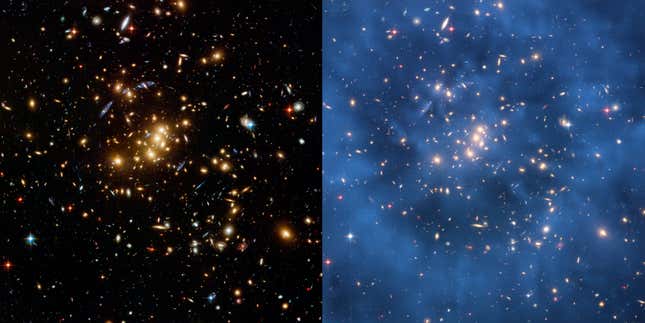
Researchers just studied the lensing of the oldest light we can see and discovered the oldest dark matter yet observed, surrounding 12-billion-year-old galaxies.
They spotted this dark matter by looking at how some galaxies warp the light of the cosmic microwave background, the earliest detectable radiation from just after the Big Bang, which kicked off the universe as we know it. The team’s research is published in Physical Review Letters.
“Most researchers use source galaxies to measure dark matter distribution from the present to eight billion years ago,” said Yuichi Harikane, an astronomer at the Institute for Cosmic Ray Research at the University of Tokyo and a co-author of the recent paper, in a Nagoya University release. “However, we could look further back into the past because we used the more distant CMB to measure dark matter. For the first time, we were measuring dark matter from almost the earliest moments of the universe.”
Dark matter makes up about 27% of the universe, though we cannot directly detect it. Because we don’t know what it is, dark matter is really a catch-all term for this unaccounted-for mass, which we see on massive scales thanks to its gravitational effects.

Some leading candidates for dark matter are small particles called WIMPs (Weakly Interacting Massive Particles) and even more minuscule particles called axions; it’s perfectly possible that both WIMPs and axions constitute dark matter. Dark matter searches are ongoing, but in the meantime, astronomers can look up and see its effects in across huge scales.
Dark matter acts as a sort of invisible glue, holding together clusters of galaxies. It also acts as a lens for more distant light, magnifying ancient objects for our observation. As much as it is an enigma, dark matter is also a boon for studying the early universe.
That’s why, when the Webb telescope recently imaged the galaxy cluster SMACS 0723, it was actually looking at all the more ancient galaxies magnified by SMACS 0723, including the most ancient galaxy yet seen, which formed 300 million years after the Big Bang.
Previous work has generally looked at shorter wavelengths through gravitational lensing, mostly objects at visible and infrared wavelengths. But the light we see from the cosmic background—the oldest light we can see—is in the microwave portion of the electromagnetic spectrum. This light started out ultra-energetic, but it was stretched out over time by the expansion of the universe, and today we see it merely as a faint microwave glow.
In the recent work, the researchers identified 1.5 million lens galaxies in visible light. They then looked at them using a telescope that sees microwave light— the ESA’s Planck satellite—and measured how much the dark matter around the nearer galaxies distorted the more ancient microwave light.

“This result gives a very consistent picture of galaxies and their evolution, as well as the dark matter in and around galaxies, and how this picture evolves with time,” said study co-author Neta Bahcall, an astronomer at Princeton University, in the same release.
The team also found that the dark matter in certain regions of space was less clumpy than it should be according to the standard theory of cosmology.
“Our finding is still uncertain,” said Hironao Miyatake, an astronomer at Nagoya University and the lead author of the paper, in the release. “But if it is true, it would suggest that the entire model is flawed as you go further back in time. This is exciting because if the result holds after the uncertainties are reduced, it could suggest an improvement of the model that may provide insight into the nature of dark matter itself.”
In the future, data from the upcoming Rubin Observatory will help by imaging huge swathes of the night sky at resolutions that will make it easier to see even more ancient parts of space.
More: The World’s Largest Digital Camera Is Almost Ready to Look Back in Time